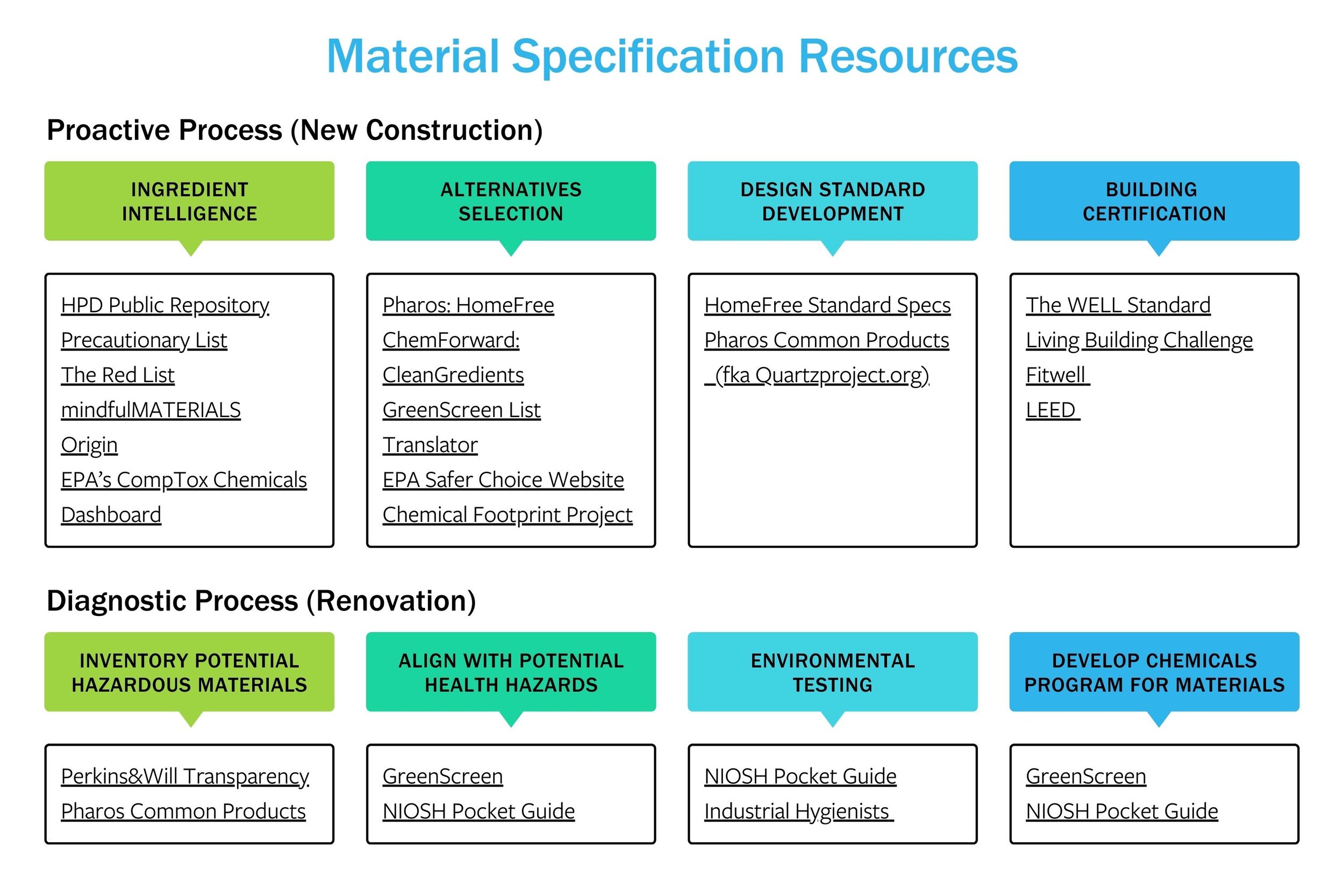Finding Safe Building Materials
By Ann Ramsey Gardner
Specifying building materials as it relates to their chemical ingredients is relatively straightforward. There are excellent databases today that have been developed by architects, toxicologists, and industrial hygienists, and are listed below by their step in the specifications process.
NEW CONSTRUCTION PROCESS
Ingredient Intelligence
HPD Public Repository – Health Product Declarations, or reporting on ingredients (chemicals) in building materials.
Pharos pulls from 47 databases (both governmental and private resources) to score 177,000+ chemicals based on 26 Health Hazard categories, and is the primary database for GreenScreen, the Precautionary List, and others.
Precautionary List – Launched in 2009 by Perkins+Will. Free. For Architects. The list is included on their Transparency website, which explains the health impact of chemicals.
GreenScreen – Launched in 2007 by Clean Production Action. Provides assessments of individual chemicals (or categories) and scores them with 20 Health Hazard categories. International standard that is Included in Pharos and toxnot.com databases.
The Red List – Developed in 2006 by the International Living Future Institute (ILFI) and represents the worst in class materials prevalent in building materials.
mindfulMATERIALS – Created in 2014 by HKS, Perkins+Will, and 43 Sponsors, and is a repository for HPD information, with a general focus on the United Nations goals. One of its original founders, GIGA, has spun off its own HPD repository, Origin.
Origin – Repository of HPD and certification information.
EPA’s ChemTox Chemicals Dashboard – 900k+ chemicals with potential health impacts.
Alternative Chemical or Materials Selection
Once research is complete, the challenge is developing criteria for design standards. LEED and other certifications frame their requirements in the reduction of chemicals below 1000 ppm typically, while others use the Precautionary Principle, in that they determine a list of chemicals which at any level, their firm feels should not be specified. I tend to agree with the latter, but it does depend on the Materials alternates available. Two resources that provide standard specifications, which are helpful in understanding ingredients at a high level, include:
EPA Safer Choice Website provides safer chemicals.
Pharos Common Products (fka Quartzproject.org) provides typical chemical ingredients by building material type. Developed by the Healthy Building Network, Google, Flux, and thinkstep.
Pharos: HomeFree ranks materials by their hazard levels, and provides additional information for alternative material selection.
Transparency website by Perkins+Will provides Project Applications, which show inventories of finishes in different room types as a way to find chemical issues.
GreenScreen List Translator scores chemicals based on information from over 40 hazard lists developed by authoritative scientific bodies
Chemical Footprint Project works with companies such as Walmart, HP, Target, and Herman Miller to establish best practices in chemical safety.
Design Standard Development
Pharos Common Products (fka Quartzproject.org)
RENOVATION PROCESS
Inventory Potential Hazardous Products
Perkins&Will Transparency
Align with Potential Health Hazards
Environmental Testing Indoors
Industrial Hygienists
Develop Chemicals Program for Materials Specification
NIOSH Pocket Guide
CIW is developing a diagnostic tool with the CDC | NIOSH organization through which a property owner, architect or engineer could search by symptom, building type, and other categories to determine why certain health issues may occur in a building and what chemicals may be the cause.

